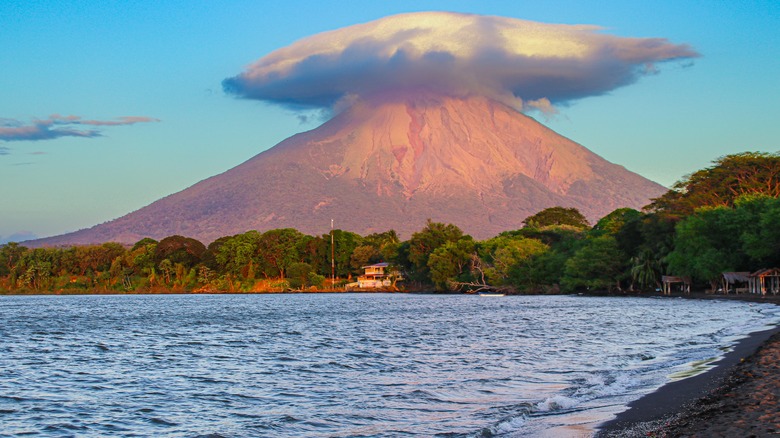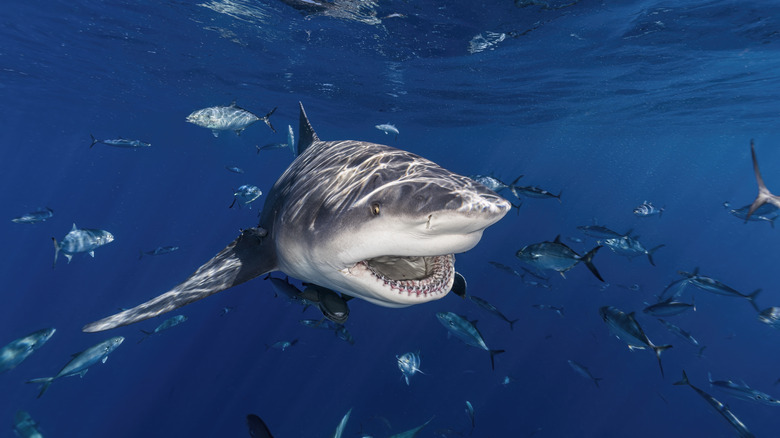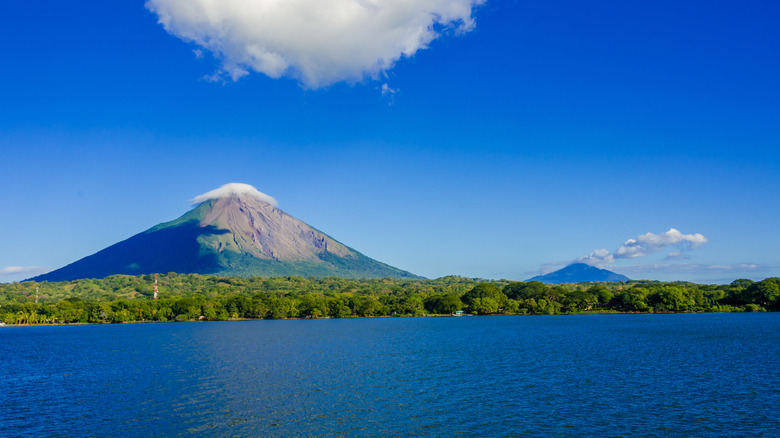The World's Only Freshwater Lake Where Oceanic Creatures Thrive Is In Central America
The Central American country of Nicaragua is often an afterthought for tourists visiting the region who perhaps prefer the trendy beach towns of Costa Rica, a scuba diving vacation on the Honduran island of Roatán, or the scenic highlands of Guatemala. But inside Nicaragua is perhaps one of the most enigmatic bodies of water on Earth — a freshwater lake that is surprisingly home to oceanic creatures, notably bull sharks.
Lake Nicaragua, also called Lake Cocibolca or Lake Granada, measures out at over 3,000 squares miles and is the largest lake in Central America. Many tourists only catch a glimpse of this sprawling body of water from Granada, a stunning and highly rated city that sits along the banks of Lake Nicaragua. But the true mysteries of the lake are found on a volcanic island inside, and within its waters. For travelers looking to combine the best of adventure, wildlife, and relaxation, there are few places that contain both like Lake Nicaragua.
Lake Nicaragua is home to bull sharks
The San Juan River connects the Caribbean sea to Lake Nicaragua and brings with it some unexpected creatures. It's common to see oceanic creatures in Lake Nicaragua like tarpon and sawfish, but there is one creature to especially keep an eye out for: the bull shark.
Bull sharks are one of a select few sea creatures that can live in both salt water and fresh water, and they have come to reside in Lake Nicaragua. Their presence in Nicaragua is the result of a unique combination of geological transformations and the adaptability of nature. It's believed that long ago Lake Nicaragua was actually connected to the ocean, until changing water levels and land transformations caused the lake to become landlocked. Although scientists are not actually sure exactly how it happened, bull sharks appeared to have been trapped inside the lake after this shift and evolved to survive there. Now, they have also evolved to be exceptionally strong swimmers and are able to migrate between the sea and the lake via the San Juan River
This curious series of events have made Lake Nicaragua's bull sharks a bucket list sighting for marine life aficionados. Although catching a glimpse of the elusive bull shark is fairly uncommon, numerous guides on the island offer kayak tours on the lake, which would be your best bet to potentially find one. But if you are lucky enough to see a bull shark, keep your distance. There have been a few cases of bull shark attacks in the lake, although they are rare and the bull sharks generally stay in areas not frequented by humans.
A volcanic island full of adventure
The place to stay on Lake Nicaragua is without a doubt Ometepe, a unique-hour glass shaped island in the middle of the lake that is composed of two volcanoes: one active and one dormant. In-between the two volcanoes are a smattering of towns Moyogalpa and Altagracia, farms, and dusty roads. Along the island's coastline, you'll find a number of lakeside hotels and hostels with incredible views of the sunrise and sunset behind the volcanoes.
Ometepe is truly a one-of-a-kind destination. In his book "Innocents Abroad" (via Outpost Magazine), Mark Twain once described the island and its two volcanoes as "magnificent pyramids. Clad in the softest and richest green, all flecked with shadow and sunshine, whose summits pierce the billowy clouds. They look so isolated from the world and its turmoil, so tranquil, so dreamy, so steeped in the slumber and eternal repose."
But as gorgeous as they are, outdoor enthusiasts will certainly want to hike one of the volcanoes while on Ometepe. Both the active Concepción volcano and dormant Maderas volcano are relatively long and strenuous hikes to the peak that take a full day and require a guide, so be prepared and support the local economy by hiring one. Afterward, laze the time away on one of the island's many docks or on the long stretch of sand at Santo Domingo beach. You can also have a soak at the Ojo de Agua, a spring pool that derives its natural warm water from the nearby Maderas volcano.


